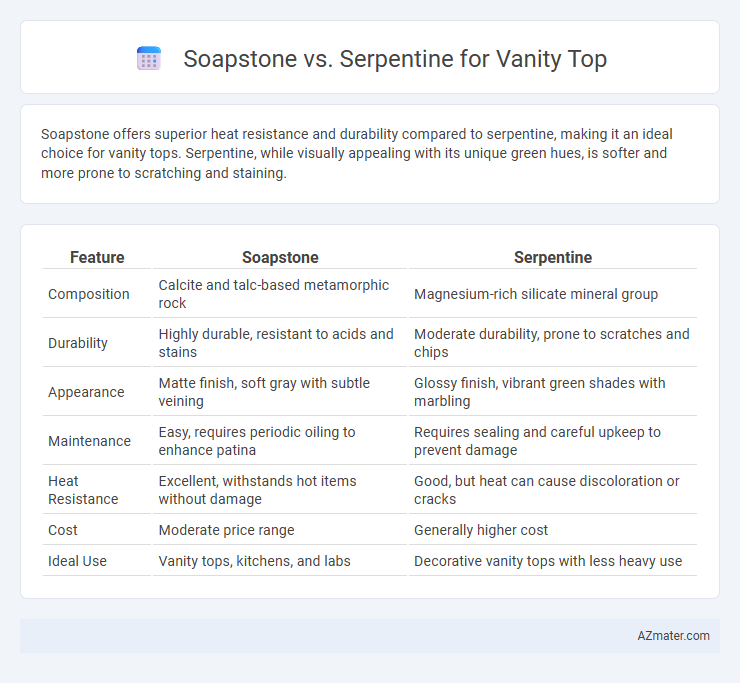Soapstone offers superior heat resistance and durability compared to serpentine, making it an ideal choice for vanity tops. Serpentine, while visually appealing with its unique green hues, is softer and more prone to scratching and staining.
Table of Comparison
| Feature | Soapstone | Serpentine |
|---|---|---|
| Composition | Calcite and talc-based metamorphic rock | Magnesium-rich silicate mineral group |
| Durability | Highly durable, resistant to acids and stains | Moderate durability, prone to scratches and chips |
| Appearance | Matte finish, soft gray with subtle veining | Glossy finish, vibrant green shades with marbling |
| Maintenance | Easy, requires periodic oiling to enhance patina | Requires sealing and careful upkeep to prevent damage |
| Heat Resistance | Excellent, withstands hot items without damage | Good, but heat can cause discoloration or cracks |
| Cost | Moderate price range | Generally higher cost |
| Ideal Use | Vanity tops, kitchens, and labs | Decorative vanity tops with less heavy use |
Introduction to Soapstone and Serpentine Vanity Tops
Soapstone vanity tops boast natural heat resistance and non-porous properties, making them highly durable and resistant to stains and bacteria, ideal for bathroom use. Serpentine vanity tops, derived from the serpentine mineral group, offer a unique blend of silky texture and vibrant green hues, providing an elegant and distinctive appearance. Both materials require regular maintenance to preserve their smooth finish and prevent etching, with soapstone generally favored for its superior durability.
Composition and Appearance: Soapstone vs Serpentine
Soapstone is primarily composed of talc, making it soft, dense, and heat-resistant with a smooth, matte finish that darkens with age, often displaying gray to greenish hues. Serpentine, a group of minerals rich in magnesium silicate, features a harder surface with a more varied color palette including green, yellow, and white, often exhibiting a mottled or veined appearance. While soapstone's uniform texture lends a classic and rustic look to vanity tops, serpentine offers a glossier, more decorative surface that can mimic marble's elegance.
Durability and Hardness Comparison
Soapstone offers excellent durability with a hardness rating of about 1 to 2 on the Mohs scale, making it resistant to heat and chemicals but prone to scratching and denting. Serpentine, often mistaken for soapstone, rates higher in hardness at approximately 3 to 5 on the Mohs scale, providing better scratch resistance and overall toughness for vanity tops. Both materials require regular maintenance, but serpentine's increased hardness typically translates to enhanced longevity in high-use bathroom environments.
Stain and Heat Resistance Properties
Soapstone exhibits excellent stain resistance due to its non-porous nature, making it highly resistant to most liquids and preventing discoloration on vanity tops. Serpentine, while attractive, is more porous and prone to staining, requiring regular sealing to maintain its appearance. Both materials offer good heat resistance; however, soapstone withstands thermal shock better, making it ideal for bathroom vanity tops exposed to hot styling tools.
Maintenance Requirements and Longevity
Soapstone vanity tops require minimal maintenance due to their non-porous nature, resisting stains and bacteria without the need for sealing, and their surface can be easily refreshed with light sanding, ensuring long-lasting durability. Serpentine, often mistaken for serpentine marble, demands more frequent sealing to prevent staining and etching, making its upkeep more intensive and potentially reducing its lifespan if neglected. Choosing soapstone ensures a durable, low-maintenance vanity top, whereas serpentine requires consistent care to maintain its appearance and longevity.
Color Variations and Design Flexibility
Soapstone offers a rich range of colors from soft grays to deep blacks with subtle veining that enhances its natural elegance, making it ideal for classic and modern vanity tops. Serpentine showcases brighter hues such as greens, yellows, and occasionally blues, providing more vibrant color variations that suit eclectic and bold bathroom designs. Both materials deliver excellent design flexibility, but Serpentine's unique patterns create striking visual statements, while Soapstone's consistent tones allow for timeless, understated sophistication.
Cost Differences Between Soapstone and Serpentine
Soapstone typically costs between $70 to $120 per square foot, making it a mid-range option for vanity tops, while serpentine tends to be less expensive, averaging $40 to $70 per square foot. The price variation is influenced by factors such as rarity, origin, and finish quality, with soapstone often valued for its durability and heat resistance. Homeowners seeking a budget-friendly material might prefer serpentine, but soapstone's premium characteristics justify its higher cost in many applications.
Installation Considerations for Vanity Tops
Soapstone offers a dense, non-porous surface that simplifies installation by reducing the need for extensive sealing and maintenance, making it ideal for vanity tops in moist environments. Serpentine, while visually appealing with its varied patterns, may require more careful handling due to its softer nature and potential for chipping during installation. Both materials benefit from professional cutting and sealing techniques to ensure a durable, long-lasting vanity top installation.
Pros and Cons: Soapstone vs Serpentine
Soapstone offers exceptional heat resistance, non-porous durability, and a smooth, matte finish ideal for bathroom vanity tops, but it can scratch easily and requires regular oiling to maintain its appearance. Serpentine is valued for its beautiful, variegated patterns and greater hardness compared to soapstone, making it more scratch-resistant, yet it tends to be less heat-resistant and more porous, which can lead to staining if not properly sealed. Choosing between soapstone and serpentine for a vanity top hinges on balancing soapstone's superior heat and chemical resistance against serpentine's stronger scratch resistance and decorative appeal.
Choosing the Best Material for Your Bathroom Vanity
Soapstone offers superior durability and stain resistance compared to serpentine, making it an ideal choice for bathroom vanity tops exposed to moisture and frequent use. Serpentine, softer and more prone to scratches, requires regular sealing and upkeep, which may increase maintenance efforts. Choosing soapstone ensures a long-lasting, low-maintenance vanity surface with a natural, heat-resistant finish that enhances bathroom aesthetics.

Infographic: Soapstone vs Serpentine for Vanity Top
 azmater.com
azmater.com